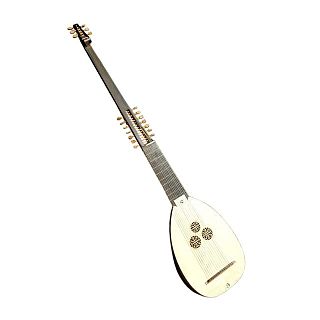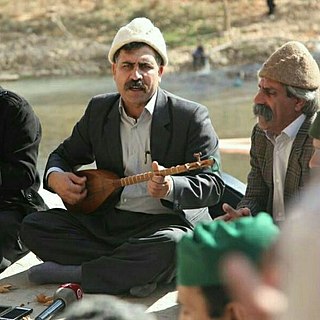Related Research Articles

A lute is any plucked string instrument with a neck and a deep round back enclosing a hollow cavity, usually with a sound hole or opening in the body. It may be either fretted or unfretted.

The oud is a short-neck lute-type, pear-shaped, fretless stringed instrument, usually with 11 strings grouped in 6 courses, but some models have 5 or 7 courses, with 10 or 13 strings respectively.

The dombra, also known as dombyra is a long-necked Kazakh and Bashkir lute and a musical string instrument. The dombyra shares certain characteristics with the komuz and dutar, such as its long, thin neck and oblong body shape. It is a popular instrument among Turkic communities in Central Asian countries such as Kazakhstan, Uzbekistan, Turkmenistan, Afghanistan, Mongolia.

The Shahnameh is a long epic poem written by the Persian poet Ferdowsi between c. 977 and 1010 CE and is the national epic of Greater Iran. Consisting of some 50,000 "distichs" or couplets, the Shahnameh is one of the world's longest epic poems. It tells mainly the mythical and to some extent the historical past of the Persian Empire from the creation of the world until the Muslim conquest in the seventh century. Iran, Azerbaijan, Afghanistan and the greater region influenced by Persian culture such as Georgia, Armenia, Turkey and Dagestan celebrate this national epic.

The theorbo is a plucked string instrument of the lute family, with an extended neck and a second pegbox. Like a lute, a theorbo has a curved-back sound box with a wooden top, typically with a sound hole, and a neck extending out from the soundbox. As with the lute, the player plucks or strums the strings with one hand while "fretting" the strings with the other hand; pressing the strings in different places on the neck produces different pitches (notes), thus enabling the performer to play chords, basslines and melodies.

Tar is an Iranian long-necked, waisted lute family instrument, used by many cultures and countries including Iran, Azerbaijan, Uzbekistan, Armenia, Georgia, Tajikistan and others near the Caucasus and Central Asia regions. The older and more complete name of the tār is čāhārtār or čārtār, meaning in Persian "four string",. This is in accordance with a practice common in Persian-speaking areas of distinguishing lutes on the basis of the number of strings originally employed. Beside the čārtār, these include the dotār, setār, pančtār, and šaštār or šeštār.

A setar is a stringed instrument, a type of lute used in Persian traditional music, played solo or accompanying voice. It is a member of the tanbur family of long-necked lutes with a range of more than two and a half octaves. Originally a three stringed instrument, a fourth string was added by the mid 19th century. It is played with the index finger of the right hand.

Rubab, robab or rabab is a lute-like musical instrument originating from Northern Pakistan and Afghanistan. The rubab is one of the national musical instruments of Afghanistan and other areas inhabited by the Pashtun,Baloch and also played by Sindhi people in Sindh and by Kashmiri people in Kashmir. It proliferated throughout West, Central, South and Southeast Asia. It derives its name from Arabic rebab 'played with a bow'; in Central Asia, however, the instrument is plucked and is distinctly different in construction.

The term Tanbur can refer to various long-necked string instruments originating in Mesopotamia, Southern or Central Asia. According to the New Grove Dictionary of Music and Musicians, "terminology presents a complicated situation. Nowadays the term tanbur is applied to a variety of distinct and related long-necked lutes used in art and folk traditions. Similar or identical instruments are also known by other terms." These instruments are used in the traditional music of Iran, India, Kurdistan, Armenia, Afghanistan, Pakistan, Turkey, Tajikistan, Kazakhstan, and Uzbekistan.

Mojmal al-Tawarikh wa al-Qasas was a book written in Ghaznavid Persia.

The Jāmiʿ al-tawārīkh, is a work of literature and history, produced in the Mongol Ilkhanate. Written by Rashid-al-Din Hamadani (1247–1318) at the start of the 14th century, the breadth of coverage of the work has caused it to be called "the first world history". It was in three volumes and published in Arabic and Persian versions. The surviving portions total approximately 400 pages of the original work. The work describes cultures and major events in world history from China to Europe; in addition, it covers Mongol history, as a way of establishing their cultural legacy.
The rud is a Persian stringed musical instrument. In Persian, the word means "string". It has been mentioned in classical Persian literature by Rudaki, Hafez, Naser Khusraw, Sanai, Ferdowsi, Nizami and Qatran Tabrizi other poets. The Arabic 'Ud, whose etymology is not yet convincingly explained, may well have been derived from the Persian word rud.

The Mastān Ensemble is an Iranian musical group performing traditional Persian music.
Django is a software program for engraving of tabulature for lutes, archlute, theorbo and other early plucked and bowed instruments. It may be an earlier or later version of "Fandango" software. It was created by the French composer, lutenist, and programmer Alain Veylit. It is currently the only program that produces tabulature in Braille.

The dutar is a traditional long-necked two-stringed lute found in Iran and Central Asia. Its name comes from the Persian word for "two strings", دوتار do tār, although the Herati dutar of Afghanistan has fourteen strings. When played, the strings are usually plucked by the Uyghurs of Western China and strummed and plucked by the Tajiks, Turkmen, Uzbeks. Related instruments include the Kazakh dombra. The Dutar is also an important instrument among the Kurds of Khorasan amongst whom Haj Ghorban Soleimani of Quchan was a noted virtuoso. In Kurdish one who plays the dutar is known as a bakci (bakhshi), while in Azeri the term is ashiq. Khorasan bakhshi music is recognized on the Representative List of the Intangible Cultural Heritage of Humanity.

The Great Mongol Shahnameh, also known as the Demotte Shahnameh or Great Ilkhanid Shahnama, is an illustrated manuscript of the Shahnameh, the national epic of Greater Iran. It is the oldest surviving illustrated manuscript of the Shahnameh, probably dating to the 1330s, and in its original form, which has not been recorded, was probably planned to consist of about 280 folios with 190 illustrations, bound in two volumes, although it is thought it was never completed. It is the largest early book in the tradition of the Persian miniature, in which it is "the most magnificent manuscript of the fourteenth century", "supremely ambitious, almost awe-inspiring", and "has received almost universal acclaim for the emotional intensity, eclectic style, artistic mastery and grandeur of its illustrations".

Lutes are stringed musical instruments that include a body and "a neck which serves both as a handle and as a means of stretching the strings beyond the body".

The Shashtar, Sheshtar or Shashtay is a stringed musical instrument of the lute family. It was mentioned historically by Evliya Çelebi and Abd al-Qadir Maraghi. It is or was played in Iran/Persia, Afghanistan, Azerbaijan and elsewhere. It may have been developed during the Safavid Dynasty from the tambur. Like the tambur, it has a floating bridge and a wooden soundboard. The 6 gut strings were in 3 double courses, and thus it may be a forerunner of the Tar.
References
- ↑ "Archived copy". Archived from the original on 2012-04-09. Retrieved 2011-10-01.CS1 maint: discouraged parameter (link) CS1 maint: archived copy as title (link)
- ↑ "The Shahnameh Guide To The Lutes Of Central Asia". Shahnameh.netlify.app. Retrieved 21 April 2021.




